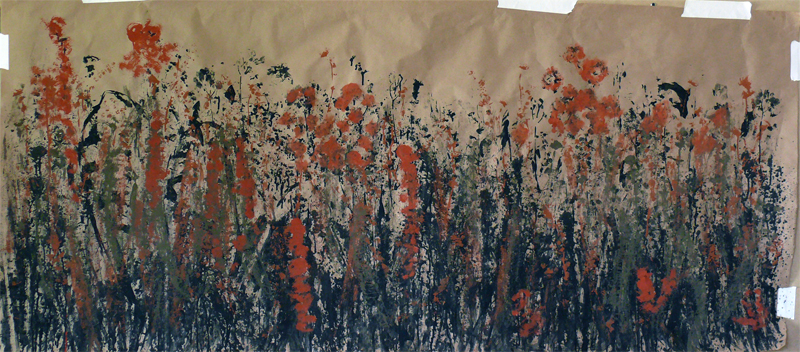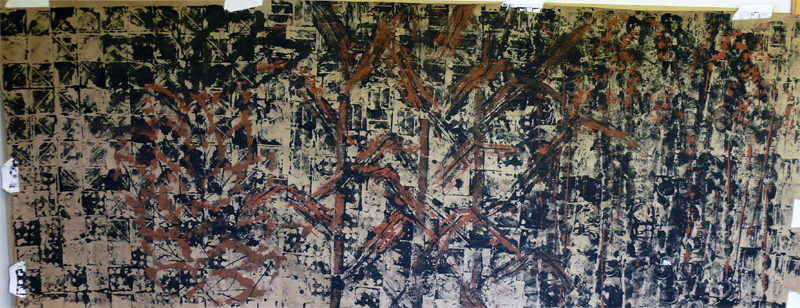May 21, 2014. Meeting with Mary Mattingly and Alex Priest at Bemis Center for Contemporary Art to discuss how I might take part in the Flock house when it is open and ready.
I brought two paintings that came out of my work as Harvest Studio with the Living Loess Tour. I give free mini-art lessons to visitors that take a self-tour to destinations up the Old Lincoln Highway and Loess Hills Trail, starting in Crescent, Iowa. I like to combine a demonstration with an opportunity for people to take part. I am still working this out, but the pieces I brought are examples of what I am working toward. I made them during a tour day which lasts from 9 -3. I hung kraft paper on the wall and worked with terra-cotta, black and brown tempera paint.
This first example is trying to represent a prairie by stamping with real prairie plants. I poured paint into a dish and dipped plants into the paint, then pressed them against the paper on the wall. In some cases I just used stems. The idea was to repeatedly do this to build up a sense of prairie texture, not brush strokes or highly abstracted, alternating light and shadow.
The next time I tried this process I decided I would build up a background first, using geometric stamps. The idea was to create a sense of texture that I could overlay with plant pressings. I brought large amaranth leaves, corn stalks and oats (left to right) to use for the overlay.
Immediately, Alex used a word that was new to me.
Palimpsest
|ˈpalimpˌsest |
(păl′ĭmp-sĕst′)
noun
Something reused or altered but still bearing visible traces of its earlier form:
A manuscript, typically of papyrus or parchment, that has been written on more than once, with the earlier writing incompletely erased and often legible.
I loved the idea of working with stamps, stencils and adding text and images to build layers. I love how it could be about the future while appearing to be something ancient.
I also wanted to develop the idea of Flock. Maybe to create large layered sheets, and then cut them into postcards to mail with messages in a flock. Or cut them into selected triangles and hang them from screens to look like a flock of birds in flight. To turn the Flock house into an exhibit that encased its own flock.
As we talked about these ideas, Alex envisioned the first layers could be made by visitors to the Flock House on public view in Bemis. New layers would be added when I moved into the Flock house for a short residency. To set up this beginning layer, we authored a prompt.
Think of something that used to be healthy, but now is toxic or perceived to be ruined. What could its contribution be? Write and draw your response.
I began to imagine an open-ended process at every stage. Before the Flock house. During the Flock house. And after? It would be dismantled and left ready for the next resident. Or be packed up and transported to its new destination.


